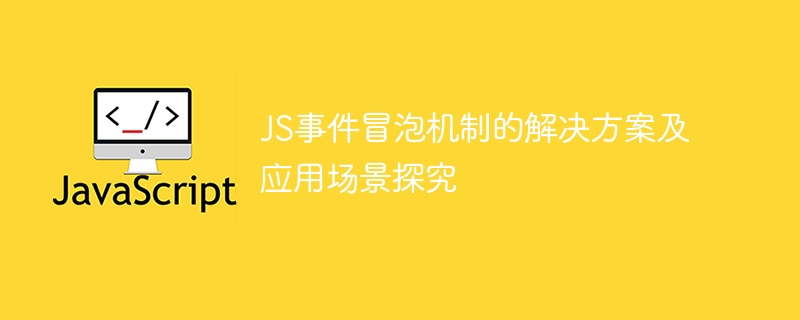
Exploration on solutions and application scenarios of JS event bubbling mechanism
The event bubbling mechanism is an important feature in JavaScript. When an event occurs on an element, such as a click event, it will automatically trigger the same event on the parent element of the element, and then bubble up to the top-level element. This mechanism can bring convenience to developers in some cases, but it can also cause some problems. This article will explore some solutions and application scenarios of event bubbling.
Solution to the bubbling mechanism:
- Use the stopPropagation() method of the event object: This method can prevent the event from bubbling up further, thereby preventing other elements from triggering the same event. For example, when a button is clicked, we do not want its parent element to also respond to the click event. We can call the stopPropagation() method of the event object in the click event handler of the button.
- Use the stopImmediatePropagation() method of the event object: This method can prevent the event from bubbling and stop the execution of other listening functions for the same event. Unlike the stopPropagation() method, the stopImmediatePropagation() method can be used in multiple event handlers on the same element. For example, if multiple click event listening functions are bound to an element, and we hope to prevent other functions from being executed after processing the logic in one of the functions, we can use the stopImmediatePropagation() method.
- Use event delegation: Event delegation is a common solution that enables event monitoring of child elements by binding the event listening function to the parent element. When an event is triggered, the event will bubble up to the parent element, and then call the event handler bound to the child element in turn. Through event delegation, we can reduce the number of event processing functions and improve performance. At the same time, if you need to dynamically add or delete child elements, there is no need to rebind the event listening function.
Application scenario:
- Selection of list or table items: In a list or table, when the user clicks on an item, we usually need to mark the item is selected and performs some related operations. Through event delegation, the click event is monitored on the parent element, and based on the clicked target element, it is determined which item the user clicked, and then the corresponding operation is performed.
- Route switching in single-page applications: In single-page applications, URL routing is usually used to implement page switching. When a link is clicked, the corresponding page needs to be loaded according to different URL paths. Through event delegation, the click event of the link is monitored on the parent element, the corresponding URL information is obtained according to the clicked target element, and then the corresponding page is loaded.
Summary:
The JS event bubbling mechanism is of great significance in Web development, but developers also need to pay attention to some details. This article introduces the solution of the event bubbling mechanism, including stopPropagation(), stopImmediatePropagation() methods and event delegation. We also explored the application scenarios of the event bubbling mechanism, such as the selection of list or table items and routing switching in single-page applications. After understanding these contents, we can better understand and use the event bubbling mechanism to improve development efficiency and performance.
The above is the detailed content of An in-depth discussion of JavaScript event bubbling issues and solutions. For more information, please follow other related articles on the PHP Chinese website!






